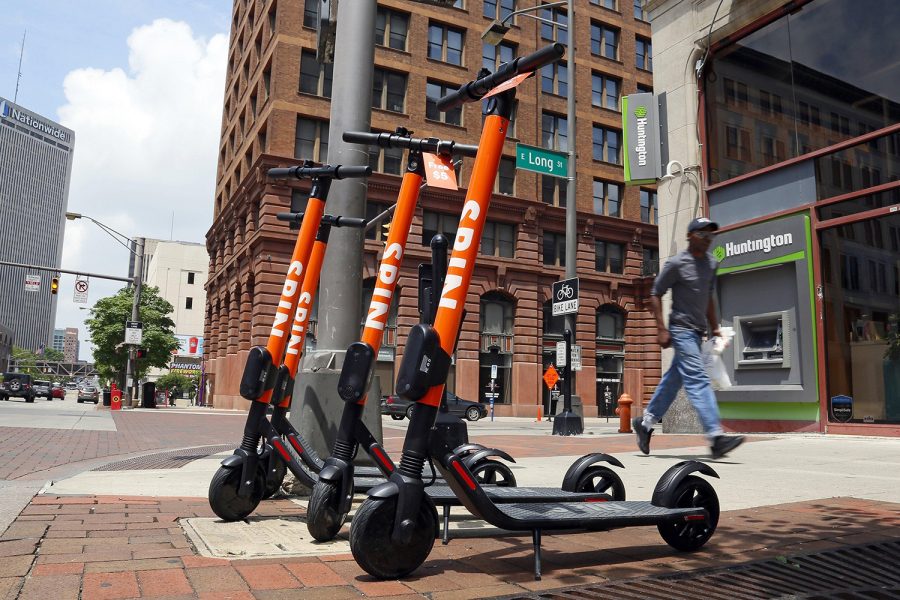Lotenschtein: Dispatches from Tel Aviv: E-scooters dominate the metropolitan area, colliding with cars and pedestrians
As a DI reporter makes her daily commute to work, she notices something new amid the rush hour traffic: e-scooters.
Spin scooters sit parked at the intersection of High and Gay streets in downtown Columbus. (Adam Cairns/Dispatch/TNS)
June 17, 2019
A pedestrian, a stray cat, and a “scooterist” — without these three, I am certain that the whole of Tel Aviv would spontaneously combust. Even though my walk from the bus stop to work is only three minutes long, I must avoid collisions with these obstacles, and although the masses of pedestrians are a breeze to maneuver through, I feel as though I have developed a sixth sense to avoid the array of “scooterists” approaching from every direction.
Granted, this is Tel Aviv, the capital of — in my opinion — insane drivers and congested sidewalks. Throughout the past few months, however, electric scooters have become the most trendy and dangerous way of transportation in the metropolitan area.
In the fall of 2018, a slew of scooter companies including Lime Electric Scooter Rentals and Bird launched hundreds of scooters in Tel Aviv. With their sleek looks and smooth ride, it’s not surprising that humans (with our adrenaline-junkie tendencies) are attracted to this method of transportation.
As the trend grew in popularity, the Israeli news media reported that e-scooters are seen as a way to alleviate traffic jams in Israel.
That flicker of hope, however, was soon blown out by 20-plus e-scooter-related deaths, a majority of which were teenagers. Israel reacted appropriately by enforcing new regulations, making it illegal to ride if you are under the age of 16 and are not wearing a helmet. With pedestrians such as me in mind, Israel also made it illegal to ride on the sidewalk, which helps me but creates a more dangerous environment for the scooterists because bicycle lanes abruptly end on the street, forcing them to ride next to cars or hit the sidewalk with the risk of being fined, starting at 250 shekels.
And so we have, ladies and gents, a bit of a problem.
E-scooters even cause pedestrians harm when they are unused, because you can simply leave them strewn across the sidewalk. Designated areas to park scooters do not exist. People find them through an app, pick up scooters, and go on their way.
Still, part of the fun isn’t getting caught, right? Residents and tourists alike continue to ride them, oblivious to the dangers around them. I see no end in sight to this trend, especially when considering Chicago’s introduction of a similar scooter system last week.
“I have seen so many accidents, so many people have died on these things,” exclaimed a Gett driver (like Uber but for Israel), throwing up his arms in frustration as a pair of scooterists rode in front of our cab. “Look, two of them ride on the scooter, now you’re not killing one but two people.”
As I trip over e-scooters, frequently dodge them on the sidewalk, and resist the urge to pick up a stray cat on the side of the road, I can’t help but think that transportation by scooter will eventually make its way to college campuses, where young people are the majority and the feeling of invincibility runs high. But we’re not invincible to accidents. In fact, we are more prone to them because of our age.
Urban jungles come with their own sets of obstacles, most which seem insurmountable to outsiders and college students like myself. But as I continue adjusting to life in Tel Aviv, these issues become less unconquerable as I observe and keep a keen eye towards a different way of life.



